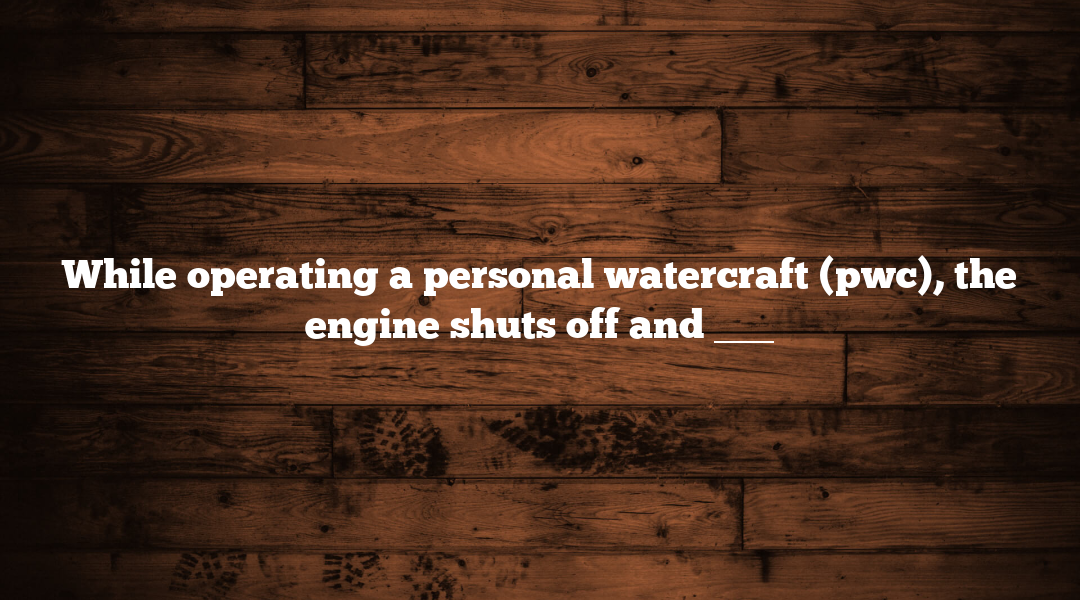While operating a personal watercraft (pwc), the engine shuts off and ___
Personal watercraft (PWC), such as Jet Skis and WaveRunners, offer thrilling adventures on the water, but the excitement can quickly turn into frustration when your PWC’s engine shuts down unexpectedly. Engine shutdowns can occur for various reasons, from simple issues to more complex problems. However, by staying prepared and informed, you can prevent and resolve PWC engine shutdowns, ensuring your rides remain smooth and enjoyable.
Understanding the Impact of PWC Engine Shutdowns
Before diving into prevention and resolution, it’s important to grasp the significance of PWC engine shutdowns.
Disruption of Enjoyment
PWC engine shutdowns not only interrupt your ride but also pose potential safety risks. Whether you’re exploring calm waters or riding the waves, a sudden loss of power can be frustrating and unsettling. To maintain the smooth sailing experience, it’s essential to be equipped with the knowledge and skills to tackle these challenges effectively.
Common Causes of PWC Engine Shutdowns
To prevent and resolve engine shutdowns, it’s crucial to identify the common culprits behind these incidents:
1. Fuel System Issues
Symptoms: Sputtering engine, abrupt shutdown.
Solution: Ensure your PWC is adequately fueled with high-quality fuel. Contaminated or dirty fuel can lead to engine problems. Regularly inspect and replace fuel filters to maintain proper fuel flow.
2. Overheating
Symptoms: Warning lights, loss of power, engine shutdown.
Solution: Examine the cooling system for clogs, damage, or obstructions. Proper water circulation is vital for cooling. Address any issues promptly to prevent engine damage.
3. Electrical Problems
Symptoms: Loss of power, sudden engine stop.
Solution: Thoroughly inspect the battery, wiring, and connections. Loose or corroded terminals can disrupt the electrical system. Make necessary repairs and ensure all connections are secure.
4. Spark Plug Troubles
Symptoms: Misfiring, rough running, engine shutdown.
Solution: Check the condition of the spark plugs and replace any fouled or damaged plugs according to the manufacturer’s recommendations. Ensure the spark plug gap aligns with your PWC’s specifications.
5. Intake and Impeller Challenges
Symptoms: Decreased performance, engine stall.
Solution: Remove any debris from the intake grate and impeller to prevent clogs and damage. Examine the impeller for signs of wear or damage and replace it if necessary.
6. Water Intrusion
Symptoms: Engine stalling, rough operation.
Solution: Drain any water from the engine compartment and inspect for leaks. Ensure that seals and gaskets are in good condition to prevent water from entering sensitive components.
Preventing PWC Engine Shutdowns
Prevention is often the best strategy when it comes to PWC engine shutdowns. Here are key steps to help you avoid these frustrating incidents:
- Regular Maintenance: Follow a maintenance schedule, including oil changes, filter replacements, and inspections.
- Fuel Quality: Always use high-quality, clean fuel with the recommended octane rating for your PWC.
- Maintenance After Use: Wash your PWC after each ride to prevent salt and debris buildup that can lead to engine problems.
- Proper Storage: Store your PWC in a dry, secure location to protect it from the elements.
- Owner’s Manual: Familiarize yourself with your PWC’s owner’s manual for specific maintenance and troubleshooting guidance.
- Safety Gear: Prioritize safety by wearing appropriate gear, including a life jacket and whistle, while operating your PWC.
Resolving PWC Engine Shutdowns
In case you encounter an engine shutdown, here’s how to resolve it and get back to smooth sailing:
Fuel System Check
- Inspect Fuel Level: Ensure you have sufficient fuel for your ride, and the fuel tank is not empty.
- Check Fuel Quality: Use clean, ethanol-free fuel to prevent engine issues. Water-contaminated fuel can lead to problems. Regularly replace clogged or dirty fuel filters to maintain proper fuel flow.
Cooling System Inspection
- Clear Cooling Path: Inspect the cooling system for debris or obstructions. Clear any blockages that hinder water circulation.
- Examine Hoses: Ensure all cooling hoses are securely connected and undamaged.
- Verify Water Flow: Start the PWC out of the water and observe if water flows through the cooling channels correctly.
Electrical System Examination
- Battery Check: Inspect the battery for a full charge and secure connections. Clean corroded terminals and connections.
- Wiring Inspection: Examine the wiring harness for damage or loose connections. Repair or replace damaged wiring.
Spark Plug Maintenance
- Remove and Inspect: Take out the spark plugs and inspect their condition. Replace any fouled or damaged plugs as per the manufacturer’s recommendations.
- Gap Adjustment: Ensure the spark plug gap aligns with your PWC’s specifications.
- Proper Installation: Reinstall spark plugs with the recommended torque to prevent damage.
Intake and Impeller Maintenance
- Debris Removal: Clear any debris from the intake grate and impeller to prevent clogs and damage.
- Damage Inspection: Examine the impeller for signs of wear or damage. Replace it if necessary.
Addressing Water Intrusion
- Drain Engine Compartment: Remove any accumulated water from the engine compartment and investigate the source of the leak.
- Seal and Gasket Check: Inspect all seals and gaskets for damage or wear and replace them as needed.
Conclusion
While PWC engine shutdowns can be a frustrating experience, they don’t have to mar your aquatic adventures. By staying prepared, implementing preventive measures, and knowing how to troubleshoot and resolve common issues, you can ensure that your rides remain smooth and enjoyable. Remember that proper maintenance and responsible operation are key to preventing PWC engine shutdowns and keeping your sailing experience a truly smooth one.






